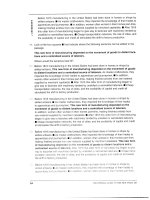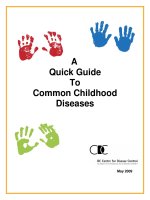Schaum''''s Quick Guide to Writing Great Research Papers - part 10 ppsx
Bạn đang xem bản rút gọn của tài liệu. Xem và tải ngay bản đầy đủ của tài liệu tại đây (67.02 KB, 18 trang )
The so-called "Golden Age" of comics officially
began in 1938. While looking for a lead feature to
launch another new title, Gaines and his editors
settled on a strip that had been created five
years earlier and unsuccessfully offered as a
newspaper strip by two teenagers from Cleveland,
Jerry Seigel and Joe Shuster. The character could
lift cars, leap over buildings, and bounce bullets
off his chest. The new magazine was named Action
Comics. The character was called Superman [Daniels
32] .
Superman proved to be an overnight success. As
quickly as they could, other publishers and DC
itself, as Gaines' company had come to be called
sought to make economic lightning strike again and
again. Costumed heroes arrived by the busload,
feeding the escapist public with fantastic adven-
tures [Savage 171 .
Not long before the second World War, impelled
by world affairs and the public mood, the comic
book industry created a number of "patriotic"
heroes: Captain America, Fighting Yank, The
Americommando, and even Uncle Sam, who began
appearing in National Comics in July of 1940. This
signaled the end of comic book escapism. As war
became part of everyday life, comics became a
vehicle for propaganda.
Military Comics was launched several months
before the United States entered World War II,
advertising "Stories of the Army and Navy." The
leading hero was Blackhawk who, we learned in the
first issue, was a Polish aviator whose family had
been killed by Nazis. He waged aerial guerrilla
warfare against Nazi Germany in his distinctive
4
Blackhawk plane which had a striking resemblance
to a Grumman skyrocket [Goulart 1811 .
Comic books became a part of the Allied propa-
ganda machine, emphasizing the need for a maximum
war effort by portraying the enemy as a vast,
inhuman evil. All variety of heroes, including
Superman and Batman, were portrayed on covers pro-
moting war bonds and punching out the "JapaNazis."
Additionally, hundreds of thousands of comics were
shipped to Allied troops around the world [Savage
10] . The audience for comics grew to astounding
proportions [Goulart 241].
After the war, however, interest in the super-
heroes began to wane. The atomic bomb was so over-
whelming that costumed strongmen no longer seemed
"super" to the American public. As a result, the
comics' publishers started looking for new genres
that would sell. Crime comics, western comics, war
comics, and romance comics all started appearing.
Like post-war Americans, comics had entered an age
of complacency.
MLJ Publications started a back-up feature
about "America's Typical Teenager" a red-haired
Romeo named Archie Andrews. Archie and his pals
Betty, Veronica, and Jughead were America's
stereotypical teenagers, sweet and carefree. They
had typical 1950s concerns: finding dates, buying
"cool" clothes, and getting Archie's jalopy to
run. Archie eventually pushed all MLJ's superheroes
off the stands, which showed how 1950s teens
favored comics that reflected the lighthearted mood
of their everyday lives.
At the same time, EC Publications (which Max
Gaines had started after leaving DC and which was
now being run by his son Bill) started grinding
out horror comics [Daniels 79] . Clearly, they were
catering to different audiences. With such titles
as Tales from the Crypt and Weird Science, Bill
Gaines and his crew set the industry scrambling in
a new direction, one that eventually spawned a
parental uproar and a Congressional investigation.
With each new rival publisher going for more
and more gory material, it was an easy task for
psychologist Fredric Wertham to blame all the ills
of society on comic books. He gained notoriety and
generated healthy sales of his book Seduction of
the Innocent. Wertham's efforts spurred Congress to
divert their attention briefly from Communism to
the issue of juvenile delinquency. Congress viewed
comics as a medium exclusively for children. Since
the comics were very violent, they would therefore
have to be altered to conform to Congress's narrow
views of acceptable reading material [Daniels 83].
Congress's attempt to clamp down on comics
reflects the general conservative attitude of the
1950s, the country's fear of "subversives" and
strangers. Their "witch hunt" against comics is a
variation of their "witch hunt" against Communists.
In an attempt to forestall Congressional action
and public backlash, the larger publishers banded
together and formed the Comics Magazine
Association, with a Comics Code for appropriate
comic book material. Like the blacklisted
"Communists," Gaines and his competitors were
forced to abandon comics virtually overnight.
Gaines himself was called before the Senate
Judiciary Subcommittee during the aforementioned
hearings on juvenile delinquency. Gaines did, how-
ever, continue on the fringe of the business, pub-
lishing a highly successful comic book-turned-maga-
zine to dodge the code: MAD [Daniels 85].
Comic books languished throughout the early and
mid-50s until Julius Schwartz, an editor at DC in
1956, proposed bringing the superheroes back for
another try. This was not a return to the escapism
of the 1930s, though. These new heroes would be
thoroughly modern "more human," claimed the pub-
lishers. Schwartz revised and revamped DCs old
lineup, including The Flash, Green Lantern,
Hawkman, The Atom, and the Justice League of
America [Crawford 326].
In part, these mythical heroes filled the need
and desire for real heroes, a role filled by base-
ball players Joe DiMaggio and Jackie Robinson,
movie stars John Wayne and Charlton Heston, and
military figure Dwight David Eisenhower.
Meanwhile, over at Atlas (formerly Timely)
Comics, publisher Martin Goodman saw the success
of his rivals and suggested to his young editor
that they should start publishing superhero comics
as well. The editor, a longtime writer of comics
for Timely/Atlas named Stan Lee, took a shot and
created the Fantastic Four, Spider-Man, the
Incredible Hulk, and the X-Men [Crawford 340].
It should be mentioned, however, that for many
years these new superhero comics were not as
reflective of American society as their predeces-
sors had been. The early sixties saw almost as
many new comic book characters as the 1940s had,
but while 1940s heroes protected the homefront in
World War II, 1960s heroes scarcely, if ever, men-
tioned Vietnam [Savage 66].
7
As the Vietnam War escalated, the popularity
of war comics decreased, with the notable excep-
tion of comics that showed the gritty, unglamorous
side of war. The DC comic Enemy Ace, for example,
described World War I from the vantage point of a
German pilot, thus humanizing the enemy. The pre-
vious generation of war comics, in contrast, had
portrayed war from the soldier's point of view.
The Sergeant Rock stories continued this new
trend, focusing much more on human relations than
on the patriotic spirit of World War II comics. By
the end of the Vietnam War, the only war comic
left was Sgt. Rock. But like any other old sol-
dier, he eventually faded away.
In the early 1970s, DC had another brief peri-
od of historical relevance as the new generation
of writers combined journalism with fiction. "Not
fact, not current events presented in panel art,
but fantasy rooted in the issues of the day, " said
Denny O'Neil, a comic author of that time,
describing these new comics. These angry issues
dealt with racism, overpopulation, pollution, and
drug addiction. DC dramatized the drug abuse prob-
lem in an unusual and unprecedented way by showing
Green Arrow's heretofore clean-cut boy sidekick
Speedy turning into a heroin addict. These comics
clearly show America's concern with the pressing
social issues of the day. While DC was showered
with praise for this bold move, declining sales
caused Schwartz to announce in 1973, "Relevance is
dead." [Goulart 297]
Also in the 1970s, the comic book industry
became aware that their audience was changing.
Instead of losing all its readers at age 14 (as
8
had been the pattern in the past), they were stay-
ing on, looking for more diverse and challenging
material. Coupled with the growth of a direct mar-
ket, in which the publishers could supply books
directly to specialized comic book shops, and the
utilization of new printing technologies, the
industry went through its largest expansion, with
record numbers of titles being produced every
month [Goulart 307]. As America became more open
about previously taboo subjects sex and violence
comics became much more gritty and realistic.
Today's comics deal with important issues on a
new level. Timely/Atlas, now called Marvel Comics,
dealt with racism in a whole new way. After they
established that their heroes were "Mutants," they
ran a crossover series about the mutant hate
groups that had sprung up in the comic-book world.
Cries of "Die Mutie scum!" echoed through the
comics with an almost Ku Klux Klan-worthy fervor
[Goulart 3321 .
A new generation of horror comics, many pro-
duced by fans-turned-professionals from England,
began to appear, aimed at an adult audience. Far
more graphic than those of the 1950s, but also
with far more complex storylines, these books in
particular have led former readers back into the
comic book fold. This echoes the way television
and movies have changed to fit the public's taste
over the past forty years [Goulart 3441 . DCs
Vertigo line targets the same audience as the TV
show Buffy the Vampire Slayer.
Over the years, as society as changed, so have
comics. Now, as the world becomes increasingly
computerized, comic companies have Web pages. In
9
addition, most of the larger comic companies are
coloring on computer rather than by hand. As the
world continues to change, the comic book industry
must continue to adapt to fit the needs and wants
of its audience if it is to survive.
10
Works Cited
Crawf ord, Hubert H. Crawford's Encyclopedia of
Comic Books. Middle Village, N.Y.: Comicade
Enterprises, 1978.
Daniels, Les. COMIX: A History of Comic Books in
America. New York: Bonanza Books, 1971.
Goulart, Ron. Great History of Comic Books.
Chicago, 111.: Contemporary Books, Inc., 1986.
Savage, William W. Comic Books and America,
1945-1954. Oklahoma: University of Oklahoma
Press, 1990.
Thomson, Don. The Comic-Book Book.
N.Y.: Arlington House, 1973.
New Rochelle,
11
Model #2: Prozac: Salvation
or Damnation?
Outline
Thesis: Prozac should be used with great care.
I. Introduction
A. Anecdotal opening
B. Thesis
Background
A. How Prozac works
B. Statistics on sale and use
Advantages of Prozac (opposition side)
A. Emotional calm
B. Fewer side effects than other antidepressants
C. Helps many patients
IV. Disadvantages of Prozac (writer's side)
A. Side effects may outweigh advantages
1.Thoughts of suicide
2.Emotional void
3.Decreased libido
4.Personality changes
S.May accelerate tumor growth
6.Other side effects
B. May be overprescribed
C. Provides only a quick fix
V. Conclusion
II.
III.
Prozac: Salvation or Damnation?
Melissa Ryder was suffering from depression. To
relieve her symptoms, her doctor prescribed Prozac.
"After only six days on Prozac, I was in far worse
shape than I had ever been before, " she said in an
interview. Her bizarre side effects included dreams
of bouncing off walls, uncontrollable trembling,
urges to stab herself, and thoughts of killing her
children. Melissa Ryder is no longer using Prozac
and her condition has improved greatly [Bowe 42].
Despite Prozac's tremendous global popularity,
some serious issues are being raised about its
negative effects. Prozac's many side effects can
do more damage than the makers of the drug could
have ever imagined, as Melissa Ryder's case illus-
trates. While Prozac can help some people suffer-
ing from depression and other mental disorders, it
should be used only with great care.
Prozac, also known by its chemical name
Fluoxtine, is the first "designer drug" created
expressly to treat depression by altering the bio-
chemistry of only one system in the brain. Prozac
interferes with the reabsorption process of sero-
tonin going into the brain. It slows down the
uptake of serotonin, making it more available to
the brain when needed [Brown 153].
In 1993, the sale of Prozac totaled $1.2 bil-
lion. A one month's supply of the drug retails for
approximately $63. Toward the end of the 1993, it
was estimated that ten million people worldwide
have taken Prozac [Breggin 47]. These figures show
that Prozac must be helping many people.
2
The drug clearly has some advantages in the
treatment of depression. Doctors boast that Prozac
affords some patients a consistent, calm feeling,
unlike that achieved through other antidepressants
that have less severe side effects than Prozac.
According to science writer Claudia Bow, 'Prozac
happens to have fewer side effects because it
alters one brain chemical (serotonin), while most
other antidepressants affect many chemical systems
in the brain" (44).
Speaking of her depression, Margaret London, an
office manager in Manhattan, said, "Everything was
gray and black. It was like being in a pit." Ms.
London tried all the different kinds of anti-
depressants currently on the market, but only
Prozac helped her. She said, "After being on
Prozac, I began to realize that I no longer felt
depressed and unhappy. I felt as if someone had
whitewashed the world" [Bowe 42].
Although Prozac was beneficial to Margaret
London, for many patients, Prozac's side effects
greatly outweigh its benefits. Prozac's negative
effects range from suicide to sexual dysfunction.
Martin Teicher, a psychiatrist from Boston
University, studied his patients on Prozac and
concluded, A significant percentage of Prozac
users were thinking of stabbing themselves, turning
on gas jets in their apartments and striking a
match to blow themselves up" ["Open Verdict" 76].
Other psychiatrists have reported similar results.
In September, 1989, a man taking Prozac shot twen-
ty people and then killed himself. His doctor said
that the man was not violent until he began taking
Prozac. As a result of this incident, lawsuits
3
amounting to hundreds of millions of dollars were
filed against Eli Lilly, the company that sells
Prozac ["Open Verdict" 76].
There are also complaints from people of feel-
ing devoid of emotions while on Prozac. Dr.
Randolph Catlin, a psychiatrist and chief of the
mental health service at Harvard University, said,
"Many of the students I treated with Prozac report-
ed feeling split off from themselves. They felt as
though they were not there any more." He added,
"One wonders if these reports that you hear about
patients acting aggressively while on Prozac might
be cases where patients who are out of touch with
their feelings act on their impulses, without hav-
ing any feelings of guilt or concern" [Nichols 39].
Dulled or absent sexual response is a problem,
too. It has been reported that some individuals on
Prozac have a decreased libido or no desire for
sexual activity. A United States study, published
in The Journal of Clinical Psychiatry in April
1994, found that among 160 patients taking Prozac,
85 reported that their sexual desire or response
diminished after using the drug [Nichols 36].
In addition, many patients on Prozac began to
experience personality changes over time. A new
study described at the annual meeting of the
American Psychiatric Association suggests that
Prozac alters aspects of personality as it
relieves depression. Ron G. Goldman, a psychiatrist
at Columbia University, believes that "Emotional
and personality factors are intertwined in depres-
sion so it's not really surprising that some type
of personality change would accompany improvement
in this condition" [Bower 359]. Similarly, psychia-
4
trist Peter Kramer, in his book Listening to
Prozac, claims, 'Prozac offers nothing less than
self transformation, turning self-doubts into con-
fidence, increasing energy, even improving one's
business acumen" [94].
In other cases, doctors have reported side
effects of a more serious nature. Some scientists
suspect that Prozac may accelerate tumor growth in
people who already have cancer. In July 1992, the
journal Cancer Research published a paper by a
group of researchers showing that tumors in mice
and rats seemed to grow faster when the animals
were given Prozac [Nichols 40] .
Prozac's other reported unpleasant side effects
include jumpiness, nausea, insomnia, unwanted
weight gain, headaches, and rapid heartbeat. "These
symptoms have appeared in hundreds of thousands of
patients," said Peter R. Breggin, MD, author of
"Another View: Talking Back to Prozac." He adds,
"When a doctor prescribes Prozac, it should be
understood that these symptoms exist and that the
risk is quite high. I believe that these warnings
go unsaid as millions of people continue to take
Prozac" [Brown 153-551 .
Prozac is now the most frequently prescribed
psychiatric medication. Physicians, mostly non-
psychiatrists, are now writing almost one million
prescriptions a month for the drug. "Many medical
experts worry that some doctors are over-prescrib-
ing Prozac and using it to treat relatively triv-
ial disorders" [Nichols 36].
In addition to overprescribing, there are prob-
lems with using Prozac as a quick-fix remedy.
Psychiatrist Peter Breggin, cited earlier, said,
5
"Too many doctors prescribe Prozac for minor
depression or anxiety without talking to patients
long enough to understand their problems. Too many
patients look for pills to smooth out the
inevitable ups and downs of everyday life"
[Breggin 46-81. Breggin argues, "In looking for
the quick fix, too many psychiatrists have forgot-
ten the importance of love, hope, and empathy in
maintaining sanity." He adds, "The main problem is
Prozac is merely a stimulant that does not get to
the root of depression and is dangerous when used
improperly" [Breggin 80].
Over time, Prozac's dark side is becoming more
apparent to the medical community and eventually
to the general public. Maybe Prozac isn't the won-
der drug of the 90s. While Prozac may help some
people, it is not a miracle cure.
6
Works Cited
Breggin, Peter. "Another View: Talking Back to
Prozac." Psychology Today. July/August 1994:
46-81.
Talking Back to Prozac. New York: St. Martin's
Press, 1994.
Brown, Avery. "Miracle Worker." People Weekly.
November 15, 1993: 153-5.
Bowe, Claudia D. "Women and Depression: Are We
Being Overdosed?" Redbook. March 1992: 42-4.
Bauer, Bruce. "Antidepressants May Alter
Personality." Science News. June 4, 1994: 359.
Kramer, Peter. Listening to Prozac. New York:
Penguin, 1993.
Nichols, Mark. "Questioning Prozac." McLean's. May
23, 1994: 36-41.
"Open Verdict : Prozac and Suicide." The Economist.
January 19, 1991: 76.
Index
Abstract, 135, 137
Audience, 18
Audiovisual sources, 56
Bias, 73, 76-78
Bibliography, 67-68
annotated, 71
working, 71
Bibliography cards, 67-72
Books in Print, 49
Boolean search, 64
Brainstorming, 12
Call numbers, 44
Card catalog, 47
reading an entry, 48
Clustering, 14
Common knowledge, 11 7-118
Computerized databases, 53
Cue words. 109-111
Dewey Decimal system, 44-47
Documentation, 83-84
guidelines, 85, 122
Footnotes, 121-122
format, 124-126, 139
guidelines, 124-125
Foreword, 135-137
Freewriting, 15
Frontmatter, 135
Glossary, 138
Government documents, 57
Guide to Reference Books, 49
"Hot" subjects, 18
Idea book, 14
Information, Please Almanac, 50
Internet, 59, 64-65, 79
Interviews, 55, 70
Introduction, 104-105
"Journalist's Questions," 15
K e y words, 40, 60, 63
Editing checklist, 144
Electronic media, 59
Ellipsis, use of, 111-112
E-mail, 62
Endmatter, 137
Endnotes, 121-122
format, 124-126
guidelines, 124-125, 139
Library o f Congress, 38, 59
Library o f Congress system, 4 4 , 46-47
Listing, 14
Loaded terms, 77
M L A Citation, 127
M L A Documentation, 119
175
Modern Language Association, 68, 119
News groups, 62
New York Times Index, The, 52
Note-taking, 85
On-line sources, 79
Outline, 93
creation, 93-94
form, 95
Pamphlets, 57
Parameters, 16, 17
Paraphrase, 87-88
Plagiarism, 88, 115-118
Portable sources, 79
Preface, 135-137
Presentation, 135, 138-139
guidelines, 139-140
Primary sources, 38-39, 55
Proofreading, 145
Proofreading symbols, 153-154
Quotations, direct, 85-86
Quotations, long, 113
Reader's Guide to Periodical Literature, 52,
54
Research paper, 3-6
definition, 3-4
endmatter, 137
frontmatter, 135
presentation, 135, 138-139
presentation guidelines, 139-140
qualities, 5, 6
Revising, 143-144
Search engines, 60, 61
Search strategy, 40
Secondary sources, 38-40
Sources, 13, 17
audiovisual, 56
books, 43, 49-50
checklist, 42
computerized databases, 53
documentation, 83-84
documentation guidelines, 85, 122
evaluation, 73-79
government documents, 57
interviews, 55, 70
on-line, 79
other, 51, 57
pamphlets, 57
periodicals, 52
portable, 79
primary, 38-39, 55
secondary, 38-40
special collections, 57-58
surveys, 55, 56
Special collections, 57-58
Style, 99
audience, 99-100
"nitty-gritty," 101
purpose, 100
Subject, 11, 21
brainstorming, 12
evaluation, 17
selection, 11-12, 18
sources, see Sources
Summary, 86
Surveys, 55, 56
T a b l e o f contents, 135-136
Term paper, 3-6
definition, 3-4
Thesis, 4
Thesis statement, 11, 29, 105-107
checklist, 34
drafting, 31
requirements, 29-31
sample, 32, 33
Time management, 6
Title page, 135-136
Topic, 11, 21-22, 30
narrowing, 21-22, 25-27
narrowing checklist, 25-27
URLS, 61, 80,125
Vertical File Index, The, 57
Visuals, 15
176
W A I S , 62
Webbing, 14
Who's Who in America, 49
"Wiggle room," 7
Works Cited page, 127-134
format, 134
World Almanac, The, 50
World Wide Web, 60, 63, 79
Writing Style, 99
177









